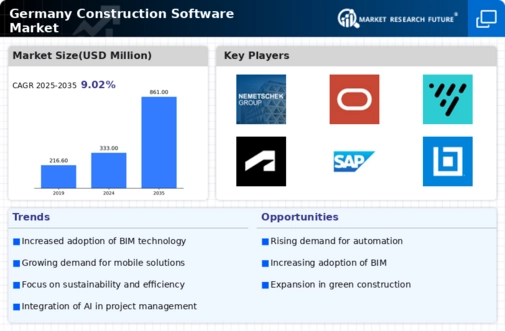The Germany Construction Software Market is characterized by several dynamic players, each employing unique strategies to capture market share and deliver innovative solutions to meet the evolving needs of the construction industry. As the industry becomes increasingly digital and project complexities grow, construction software is gaining momentum, enabling companies to improve efficiencies, reduce costs, and enhance project collaboration. In this competitive landscape, key players utilize advanced technologies, including Building Information Modeling (BIM), cloud computing, and data analytics, to gain an edge and address the specific challenges faced by the German construction sector.
The market is poised for growth, supported by increasing infrastructure investments and a focus on sustainability and regulatory compliance.
Nemetschek stands out prominently in the Germany Construction Software Market, recognized for its comprehensive suite of tools aimed at enhancing architectural design and project management. The company leverages its strengths in BIM technology, providing solutions that facilitate collaboration among architects, engineers, and contractors. Its software solutions are deeply embedded in the design and construction processes, allowing for optimized workflows and a streamlined project lifecycle. Nemetschek's significant market presence is bolstered by its strong brand reputation and long-standing relationships with key stakeholders in the German construction sector.
The firm continuously innovates to augment its software capabilities, ensuring that it meets the current needs of the industry while anticipating future trends.
Oracle, within the context of the Germany Construction Software Market, offers a robust range of solutions that cater to various aspects of construction project management. Its key products, including Oracle Primavera, focus on improving project scheduling, resource management, and risk analysis, making it a vital tool for large-scale construction projects. The company commands a strong market presence, leveraging its global expertise to adapt solutions specifically for the German market. Oracle's strengths lie in its integration of cloud technology, which enables real-time data usage and collaboration across projects.
The firm has also engaged in strategic mergers and acquisitions to enhance its portfolio, allowing it to provide a comprehensive suite of solutions tailored for the unique requirements of the construction industry in Germany. These efforts fortify Oracle’s position as a competitive player in the market, equipped to offer scalable and cutting-edge technology to construction firms across the region.























